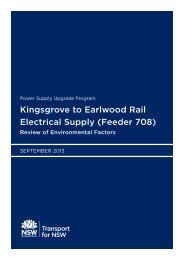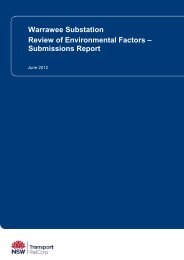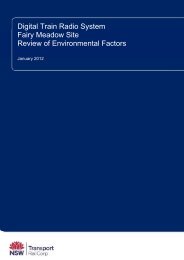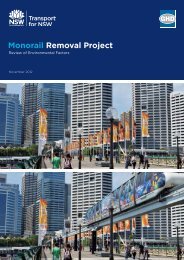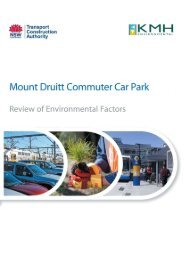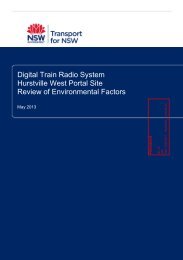Warrawee Substation - Review of Environmental Factors
Warrawee Substation - Review of Environmental Factors
Warrawee Substation - Review of Environmental Factors
- No tags were found...
You also want an ePaper? Increase the reach of your titles
YUMPU automatically turns print PDFs into web optimized ePapers that Google loves.
<strong>Warrawee</strong> <strong>Substation</strong> Page 27Operational Noise & Construction Noise & Vibration AssessmentReport No. 11332 Version B7.2 Building DamageIn terms <strong>of</strong> the most recent relevant vibration damage objectives, Australian Standard AS 2187:Part 2-2006 “Explosives – Storage and Use – Part 2: Use <strong>of</strong> Explosives” recommends thefrequency dependent guideline values and assessment methods given in BS 7385 Part 2-1993“Evaluation and measurement for vibration in buildings Part 2” as they “are applicable toAustralian conditions”.The British Standard sets guide values for building vibration based on the lowest vibration levelsabove which damage has been credibly demonstrated. These levels are judged to give aminimum risk <strong>of</strong> vibration-induced damage, where minimal risk for a named effect is usuallytaken as a 95% probability <strong>of</strong> no effect.The recommended limits (guide values) from BS7385 for transient vibration to ensure minimalrisk <strong>of</strong> cosmetic damage to residential and industrial buildings are presented numerically inTable 7-3 .Table 7-3Transient Vibration Guide Values - Minimal Risk <strong>of</strong> Cosmetic DamageType <strong>of</strong> BuildingReinforced or framed structuresIndustrial and heavy commercial buildingsPeak component particle velocity in frequencyrange <strong>of</strong> predominant pulse4 Hz to 15 Hz 15 Hz and above50mm/s at 4 Hz and aboveN/AUnreinforced or light framed structuresResidential or light commercial type buildings15mm/s at 4 Hz increasing to20mm/s at 15 Hz20mm/s at 15 Hz increasing to50mm/s at 40 Hz and aboveThe Standard states that the guide values in Table 7-3 relate predominantly to transientvibration which does not give rise to resonant responses in structures, and to low-rise buildings.Note that rock breaking / hammering and sheet piling activities are considered to have thepotential to cause dynamic loading in some structures (e.g. residences) and it may therefore beappropriate to reduce the transient values by 50%.The British Standard goes on to state that “Some data suggests that the probability <strong>of</strong> damagetends towards zero at 12.5 mm/s peak component particle velocity”. In addition, a building <strong>of</strong>historical value should not (unless it is structurally unsound) be assumed to be more sensitive.



